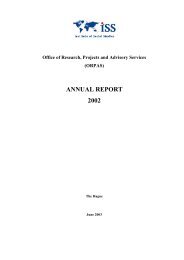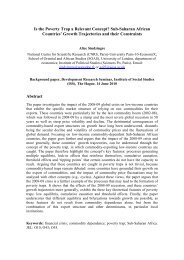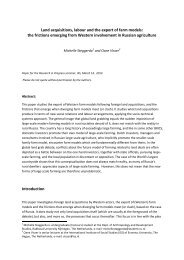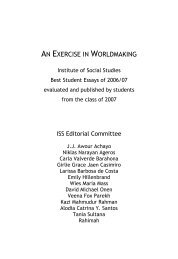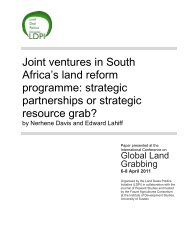AN EXERCISE IN WORLDMAKING 2009 - ISS
AN EXERCISE IN WORLDMAKING 2009 - ISS
AN EXERCISE IN WORLDMAKING 2009 - ISS
You also want an ePaper? Increase the reach of your titles
YUMPU automatically turns print PDFs into web optimized ePapers that Google loves.
202 CH<strong>AN</strong>TELLE DE NOBREGA<br />
know exactly what we are dealing with: which violation or crime, against<br />
whom, by whom and when. And yet, the experience of violence, oppression<br />
and social exclusion is different for each individual and community<br />
depending on their location in this nexus of discrimination and identity.<br />
Thus, improving labour rights on paper, while important, does little to<br />
address women’s rights if it does not take into account the way women<br />
experience institutional gendered discrimination and how this intersects<br />
with class or ethnicity. The importance we place on these categories<br />
means that they support a particular system as they<br />
are the pathways, the mechanisms though which societies assign and attribute<br />
identities… They determine the way we think, the way we frame<br />
the world, and the way the world perceives and treats us. Thus categories<br />
exert a profound influence on our lives because some categories are given<br />
more importance than others; some categories wield more influence and<br />
are more powerful than others and some categories marginalize other<br />
categories and silence their points of view (Raj 2003: v).<br />
Raj’s latter point about the impact of categorisation on influence and<br />
power goes to the heart of Crenshaw’s characterisation of political intersectionality.<br />
Political, legal and social practices directly and discursively<br />
create and recreate frameworks through which we understand identity,<br />
oppression, discrimination and victimhood, and often “erase” marginal<br />
voices, such as those of women of colour. Institutions and processes<br />
which address racism, sexism and other forms of oppression as separate<br />
and mutually exclusive, can create exclusionary practices as they embrace<br />
what Crenshaw calls “monocausal frameworks” (1993: 112). This is the<br />
trap that some human rights lawyers, activists and treaty bodies have<br />
fallen into. The prioritisation of human rights issues is strongly influenced<br />
by the dominant voices within the global human rights community.<br />
Thus, how a problem is framed, and hence the solution, are often<br />
the result of how those with access have understood a particular issue.<br />
The impact of this monocausal approach, as well as how it shapes political,<br />
legal and social discourses on any particular issue, has multiple dimensions.<br />
Firstly, the value of interventions or “solutions” that are<br />
adopted at the international level (in conventions, law and practice) is<br />
diminished by the lack of an intersectional understanding and approach.<br />
For example, undocumented migrants (as a whole) struggle to ensure<br />
that their human rights are fully recognised and protected. This can be<br />
made far more difficult and complex, however, if the migrant is a woman




